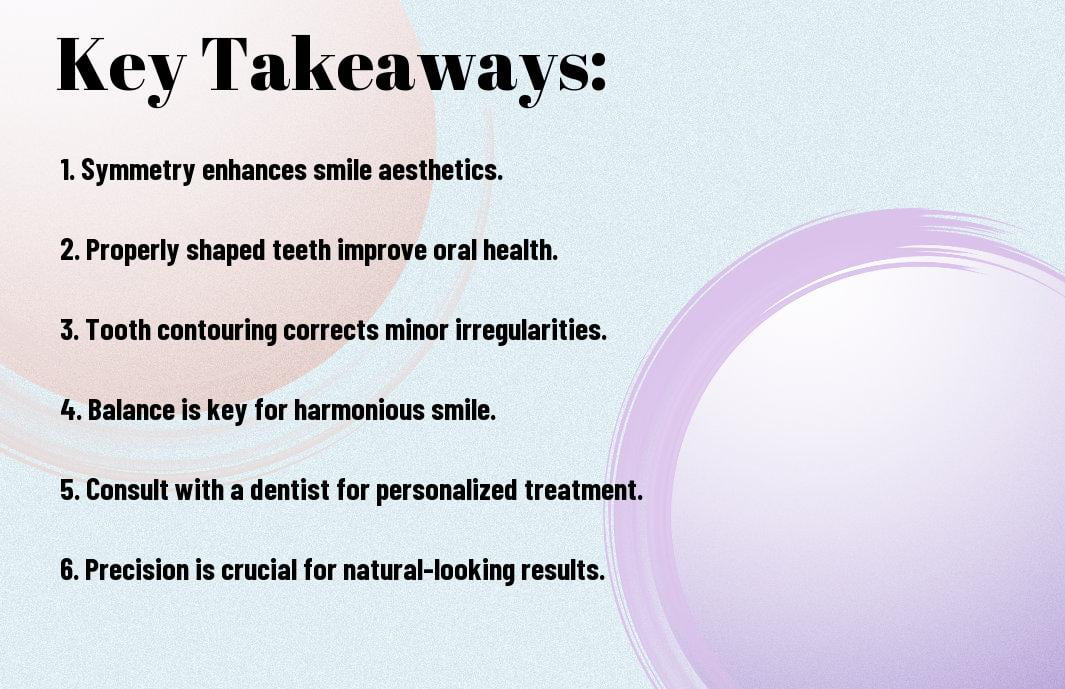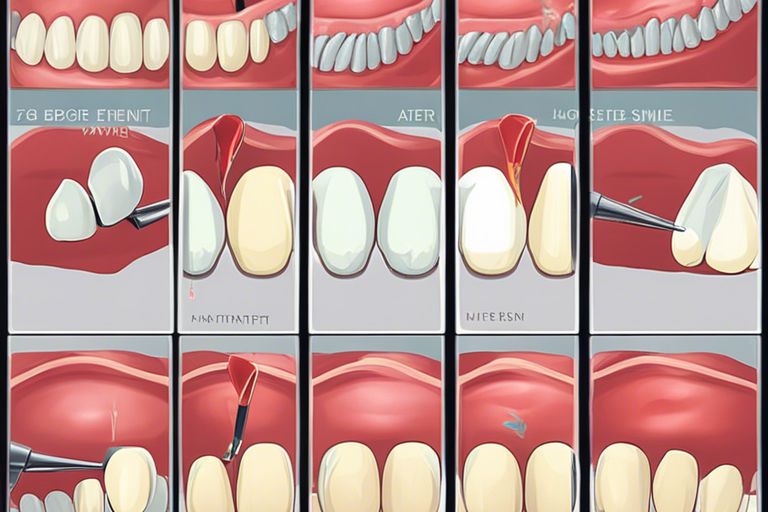Most dental professionals strive for the perfect balance and symmetry in tooth contouring to enhance a patient’s smile. Mastering the art of tooth contouring requires precision, attention to detail, and a deep understanding of facial aesthetics. In this informative guide, you will learn imperative techniques and tips to achieve harmonious results in tooth contouring, creating beautiful, natural-looking smiles that will leave your patients feeling confident and happy.
Key Takeaways:
- Symmetry in Tooth Contouring: Achieving symmetry in tooth contouring is crucial for enhancing the overall aesthetics of a patient’s smile. It involves precise shaping and sculpting of the teeth to ensure a harmonious balance.
- Importance of Balance: Maintaining the balance between different aspects of tooth contouring, such as shape, size, and alignment, is imperative for creating a natural and pleasing appearance. Attention to detail is key in achieving optimal results.
- Patient-Centric Approach: To achieve symmetry and balance in tooth contouring, a patient-centric approach is imperative. Understanding the individual’s facial features, smile line, and personal preferences is crucial for tailoring the treatment to meet their specific needs and expectations.

Principles of Symmetry and Balance
Definition and Importance of Symmetry in Dentistry
The concept of symmetry in dentistry refers to achieving a harmonious balance between the right and left sides of the face, particularly in the positioning and contouring of teeth. Symmetry plays a crucial role in creating a pleasing aesthetic appearance, as our brains are naturally drawn to balanced and proportionate features. Pertaining to tooth contouring, symmetry is imperative in ensuring that the final result looks natural and enhances the overall facial aesthetics.
Balance and Harmony in Tooth Contouring
To achieve balance and harmony in tooth contouring, you must carefully consider the shape, size, and position of each tooth relative to the surrounding teeth and facial structures. By analyzing the patient’s facial features, smile line, and gum line, you can determine the most suitable contouring approach to optimize symmetry and balance. This attention to detail is vital in creating a successful outcome that not only improves the patient’s smile but also complements their overall facial appearance.
Tooth contouring involves reshaping the enamel of the teeth to correct imperfections such as chips, overlaps, or uneven lengths. By strategically removing small amounts of enamel, you can achieve a more uniform and balanced look that enhances the symmetry of the smile. When done correctly, tooth contouring can make a significant difference in improving the overall harmony of the teeth and facial features.
Anatomy and Morphology of Teeth
While performing tooth contouring, it is important to have a profound understanding of the anatomy and morphology of teeth. This knowledge will guide you in achieving symmetry and balance in your contouring efforts.
Tooth Shape and Size Variations
To create harmony in tooth contouring, it is crucial to recognize the various shape and size variations that exist among teeth. Each tooth type has distinct characteristics that must be considered when reshaping the teeth to achieve optimal symmetry and balance.
Facial and Lingual Aspects of Teeth
To ensure symmetry in your tooth contouring process, you must pay close attention to both the facial and lingual aspects of the teeth. The facial aspect refers to the side of the tooth that is visible when you smile, while the lingual aspect is the side that faces the tongue.
Understanding the differences in anatomy between the facial and lingual aspects of teeth is crucial for achieving balance in your contouring work. By carefully sculpting both aspects of the tooth, you can create a harmonious alignment that enhances the overall aesthetics of the smile.
Assessing Symmetry and Balance
Despite the complexity of achieving symmetry and balance in tooth contouring, a crucial first step is to assess the existing structure of the teeth. This assessment will allow you to determine the areas that need adjustment to create a harmonious and balanced smile.
Visual Examination and Diagnosis
The visual examination of the teeth is the initial step in determining the symmetry and balance of the smile. You should carefully observe the shape, size, and alignment of the teeth to identify any discrepancies. Pay close attention to the midline, tooth proportions, and overall facial symmetry when diagnosing the areas that require contouring.
Measurement Techniques and Tools
For precise measurements and analysis of tooth structure, various tools and techniques can aid in achieving symmetry and balance in tooth contouring. Tools such as digital calipers or periodontal probes can help you accurately measure tooth dimensions, contours, and discrepancies. Additionally, photography and digital imaging software can assist in visualizing the proposed changes and predicting the outcome of the contouring process.
Visual aids can be vital in providing a clear visual representation of the proposed adjustments to the patient. By using these measurement techniques and tools, you can enhance your ability to achieve symmetry and balance in tooth contouring effectively.
Tooth Contouring Techniques
Once again, achieving symmetry and balance in tooth contouring involves a variety of techniques that can help enhance the overall appearance of a patient’s smile. As a dental professional, you have the skills and knowledge to perform these techniques to perfection, ensuring your patients leave with a smile they are proud of.
Enameloplasty and Odontoplasty
Contouring through enameloplasty and odontoplasty involves reshaping the tooth by removing small amounts of enamel or dentin. This technique is commonly used to correct minor imperfections such as uneven teeth or small chips. By skillfully removing excess material, you can create a more harmonious appearance and help your patients achieve the symmetrical smile they desire.
Reshaping and Recontouring Teeth
Recontouring teeth goes beyond simply removing enamel; it involves reshaping the tooth to improve its size, shape, and position within the arch. This technique requires precision and attention to detail to ensure that the final result is both functional and aesthetically pleasing. By mastering the art of reshaping and recontouring teeth, you can help your patients achieve the balanced and symmetrical smile they have always wanted.
For instance, reshaping and recontouring can be particularly beneficial in cases where a patient has irregularly shaped or overlapping teeth. By carefully sculpting the teeth into a more harmonious alignment, you can transform their smile and boost their confidence. Your expertise in these techniques will not only enhance your patient’s appearance but also improve their overall oral health and well-being.
Achieving Symmetry and Balance
After carefully assessing your patient’s smile, you may find that achieving symmetry and balance through tooth contouring can greatly enhance their overall dental aesthetics. Restoring balance through tooth contouring involves reshaping teeth to create uniformity and harmony within the smile. By strategically removing small amounts of enamel, you can adjust the size and shape of teeth to create a more balanced appearance.
Restoring Balance through Tooth Contouring
Restoring balance through tooth contouring is a minimally invasive procedure that can make a significant difference in your patient’s smile. By carefully sculpting the enamel of the teeth, you can correct minor imperfections and create a more harmonious alignment. This technique is particularly useful for addressing asymmetrical teeth or uneven tooth heights, helping to establish a more balanced overall look.
Creating Symmetry through Dental Bonding and Veneers
For more extensive cases where tooth contouring alone may not achieve the desired results, creating symmetry through dental bonding and veneers can provide a transformative solution. Dental bonding involves applying a tooth-colored resin material to the teeth to reshape and enhance their appearance. Veneers, thin shells custom-made to fit over the front surface of the teeth, can also be used to create symmetry and balance by masking imperfections and improving tooth shape.
Balance is key in achieving optimal dental aesthetics, and by combining techniques such as tooth contouring, bonding, and veneers, you can help your patients achieve a more symmetrical and balanced smile. Working with your patient to determine their goals and addressing any concerns will ensure a customized treatment plan that enhances both the appearance and function of their teeth.
Common Challenges and Complications
Over-Contouring and Under-Contouring Teeth
Unlike other dental procedures, tooth contouring requires a delicate touch and precise technique to avoid over-contouring or under-contouring teeth. An over-contoured tooth can lead to sensitivity, bite issues, and an unattractive appearance. Conversely, under-contouring may not address the intended aesthetic goals, leaving the patient dissatisfied with the results.
Managing Patient Expectations and Communication
With any cosmetic dental procedure, managing patient expectations and effective communication are crucial. You must discuss the potential outcomes of tooth contouring with your patient, addressing both the benefits and limitations. By setting realistic expectations and listening to their concerns, you can ensure patient satisfaction and a successful treatment outcome.
For instance, some patients may have unrealistic expectations about the dramatic changes tooth contouring can achieve. It’s imperative to educate them on what is realistically possible and provide alternatives if their desired results are not feasible through tooth contouring alone. Open and honest communication will help build trust and ensure a positive patient experience throughout the process.
Conclusion
Summing up, achieving symmetry and balance in tooth contouring is crucial for creating aesthetically pleasing smiles for your patients. By carefully assessing the shape and size of each tooth, you can make precise adjustments to bring about harmony and balance. Remember to consider factors such as facial symmetry, tooth proportions, and the patient’s unique features to achieve the best results.
Through careful planning and meticulous execution, you can enhance the natural beauty of your patients’ smiles, boost their confidence, and ultimately improve their quality of life. By mastering the art of tooth contouring, you can create stunning results that will leave a lasting impact on your patients and set you apart as a skilled and knowledgeable dental professional.
FAQ
Q: Why is achieving symmetry and balance important in tooth contouring?
A: Achieving symmetry and balance in tooth contouring is crucial as it helps to enhance the aesthetic appearance of the patient’s smile. Symmetry and balance contribute to a harmonious overall look, ensuring that the teeth appear natural and well-proportioned.
Q: What factors should be considered when aiming for symmetry and balance in tooth contouring?
A: When striving for symmetry and balance in tooth contouring, factors such as the patient’s facial structure, tooth shape, and smile line should be carefully evaluated. Additionally, the functional aspects of the teeth, such as occlusion and bite, must also be taken into account to ensure optimal results.
Q: How can dental professionals achieve symmetry and balance in tooth contouring procedures?
A: Dental professionals can achieve symmetry and balance in tooth contouring by utilizing techniques such as digital smile design, mock-up procedures, and meticulous planning. By customizing the treatment plan to each patient’s unique needs and carefully executing the contouring process, dental professionals can achieve precise and satisfying results.






